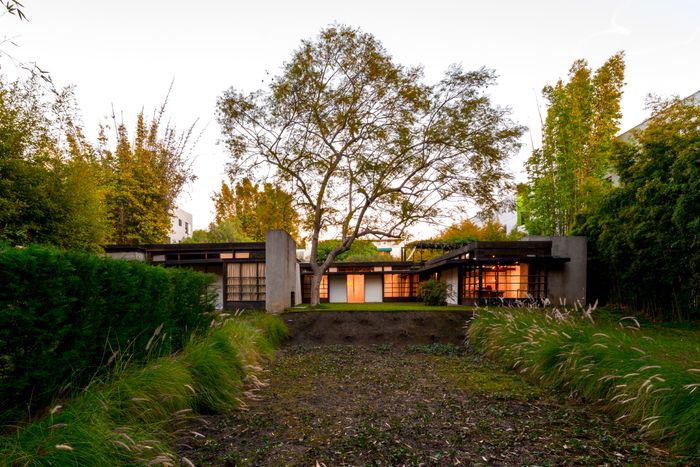
Sandra Oh is the Cut’s July/August cover star! Later this month, the acclaimed actress will lead a new Netflix dramedy series, The Chair. She also currently stars as Eve Polastri in Killing Eve, a role that she at first didn’t realize she was being asked to audition for, telling Vulture in 2018 that she was “brainwashed” into thinking she could only play supporting roles as an Asian woman. Since then, the BBC America series has been a critical and global success and a worthy showcase of Oh’s talent and poise. To best capture those qualities in the cover shoot, photographer James Wright brought Oh to a Los Angeles architectural wonder, the Schindler House, for a collaborative and somewhat experimental session. “[Oh] really exceeded all expectations. Of all the actors I’ve worked with, she was very special. It’s cheesy, but she was incredibly giving and collaborative,” he gushes.
Wright, founder of and editor for the arts and culture magazine So It Goes, shot the August cover entirely in film, an artistic choice that kept everyone from overthinking each individual shot and that admittedly also suited their schedule, as Oh had a flight to catch to continue production for Killing Eve. “There wasn’t an analysis of every frame,” Wright explains,
“and I’m pretentious enough to still think the film gives a warmth and a texture to the picture itself. You get really rich colors, and it contributes a bit more fun.” Also special was their chosen location: Schindler House, an historically significant site in West Hollywood where Wright has long wanted to photograph. “It feels weird and incongruous to be here. [The house] has always been on my moodboards,” he says, referencing its uniquely European style. “We had a few shots in the back of the property that could have been taken in the south of France.”
The building is a curiosity. Considered to be the “birthplace of Southern California modernism,” the eponymous house was created by Austrian architect Rudolph M. Schindler. Designed in 1921 and incorporating the visions of both Schindler and his wife, Pauline, it was constructed only a year later. In 1932, 10 years after its completion, MoMa hosted its inaugural architecture exhibit, “Modern Architecture: International Exhibition,” highlighting a then-new design phenomenon: modernism. Schindler’s style, while not completely aligned with everything on display, was certainly fitting, as he worked with many of the talents featured in the exhibition, including Frank Lloyd Wright and Richard Neutra. “There are a lot of names around Schindler that became famous, and he was a lesser-known figure, but historians always point back to how he was already working on what was defined as modernism in Los Angeles, ten years earlier,” says Jia Gu, an architectural historian and director of the MAK Center, which currently has its headquarters at the Schindler House.
On top of being ahead of its time, the Schindler House’s design blurs the lines between indoor and outdoor space, using a slab tilt wall, which, according to Wright, provided a lot of abstractions to play with during the cover shoot. “I never had to show the house too much. Because of the interesting design, it could be the edge of a beam, or the corner of the wall, or the way the light hits the concrete through the trees,” Wright says. The house was designed, in Schindler’s own words, as “a real California scheme.” Each room has an entire wall open to the outdoors to make the occupants feel like they’re a part of nature, evoking the experience of staying in a tent on a campground. Gu credits the design’s beauty to Schindler’s desire for utility — electricity was only just being introduced to domestic homes in 1922, and the Austrian-born architect was most likely not used to California’s weather. “This was a house that was designed with the California climate in mind,” Gu says. “Though we can’t say [the open design] is entirely his invention, I do think that was why there was more fluidity between indoor and outdoor spaces.”
While our shoot was a great time, it was nothing in comparison to the parties that were once hosted at the site. Both Rudolph and Pauline Schindler were known socialists, and they participated in the avant-garde art scene. During the time that the couple lived in the house together, Pauline worked to establish it as a “mecca for left-wing political activity,” per Gu, and the pair hosted constant social gatherings until the end of the 1920s, when they divorced. In the years following, Pauline traveled up and down the California coast before returning to live in the house with Rudolph as a separated couple until he died in 1950.
Following Rudolph’s death, Pauline watched as many nearby architectural gems in the rapidly changing neighborhood were demolished, and she decided to establish the Friends of Schindler House, or FOSH, to ensure the building’s preservation. FOSH is in charge of the Schindler House’s material preservation to this day, and the MAK Center, a satellite institution of the Museum of Applied Arts, is dedicated to stewarding three of Schindler’s architectural masterpieces: the aforementioned house, the Mackey Apartments, and the Fitzpatrick-Leland House.
The MAK Center’s mission is to advance the public conversation around architecture within Los Angeles, starting with the Schindler House. “When we think of architecture, we think about the building and the developer. We think about it as real estate,” Yi Gu says. “But we can understand the Schindler House through the perspective of concrete history. We understand it as the center for experimentation for the avant-garde in the 1920s and 1930s. There are so many stories that can be told through it.” For the story told we through the Schindler House, read our July/August cover story here.
"behind" - Google News
August 02, 2021 at 08:00PM
https://ift.tt/3ik7SvS
Behind the Cover: Sandra Oh - The Cut
"behind" - Google News
https://ift.tt/2YqUhZP
https://ift.tt/2yko4c8
Bagikan Berita Ini


















0 Response to "Behind the Cover: Sandra Oh - The Cut"
Post a Comment